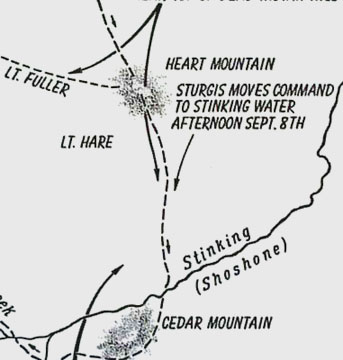
Col. S.D. Sturgis
Waiting a full day longer than the time agreed upon for the return of our scouts, the Colonel became anxious, and dispatched two scouting parties ... with orders to penetrate into the range and try and discover traces of our overdue scouts.
Pvt. Theodore Goldin
About 3 o'clock p.m. Lieutenant Hare returned, reporting that when about 16 miles out he had come upon the two scouts previously sent out, one of them dead and the other in a dying condition; that these scouts had been attacked by about thirty Indians (as indicated by the pony tracks) who had come apparently from the direction of the Stinking [Shoshone] River. While Lieutenant Hare was making his report Lieutenant Fuller also returned, reporting that when about 18 miles out he had seen from the top of a high mountain what appeared to be the hostiles, moving on the Stinking River trail, and that they had disappeared behind a range of mountains.... The guide who accompanied him (and who had also been engaged in prospecting among these mountains) assured me that from the point where the Indians had disappeared behind the mountain range, it was altogether impossible for them to cross over to Clark's Fork, and that they must necessarily debouch on the Stinking River.

Col. S.D. Sturgis

With this latest information, Sturgis concluded that the Nez Perce must be headed south to the Stinking Water. When he arrived at the Stinking Water River and found no trace of the Nez Perce, he knew he had been outwitted. .
Circling back through the mountains, Sturgis converged with the trail of the Nez Perce and Howard's troops near Dead Indian Pass. Scrambling down into Clarks Fork Canyon on the route he had been told did not exist, Sturgis caught up with Howard a few miles below the mouth of the canyon.